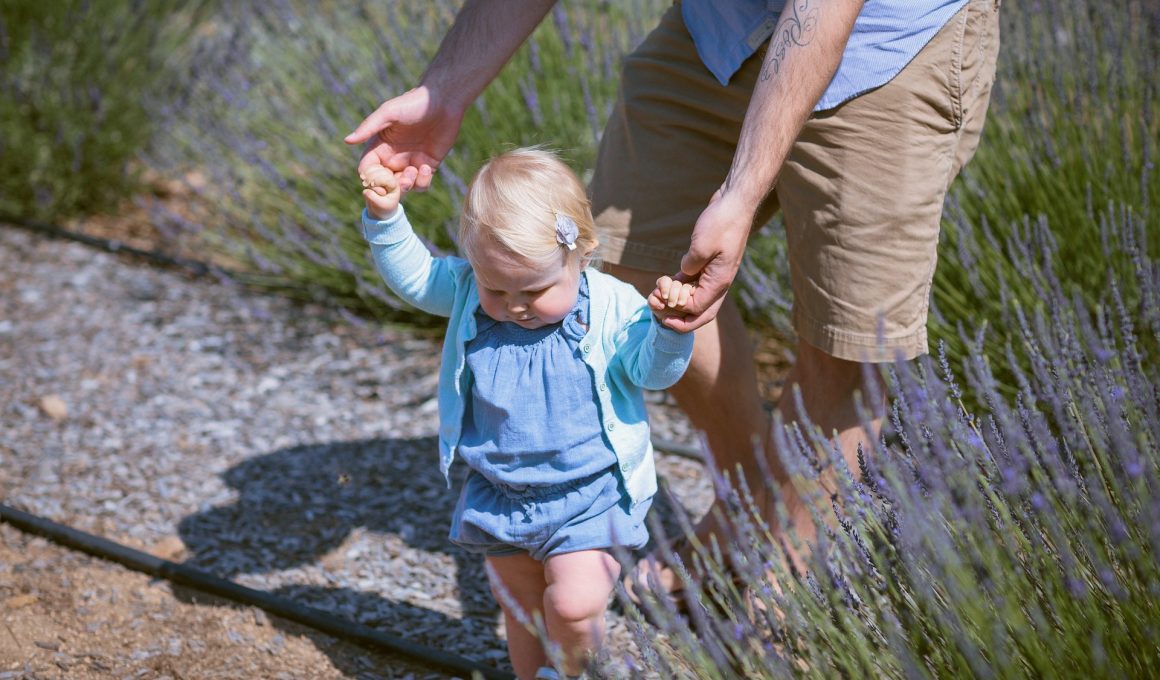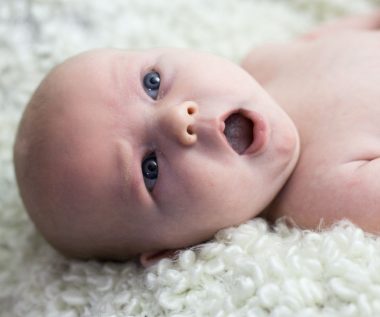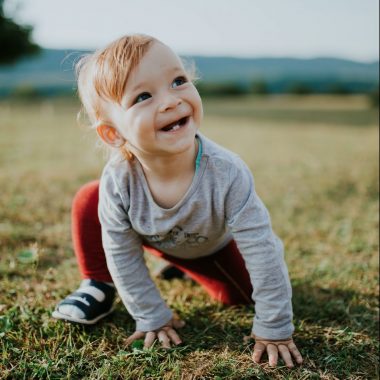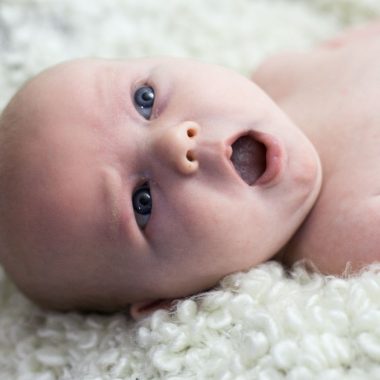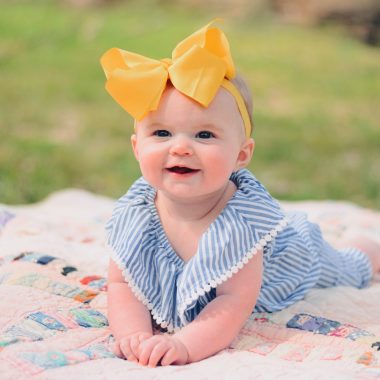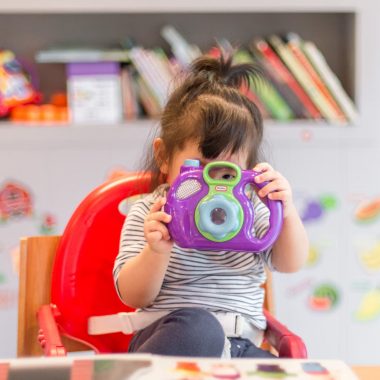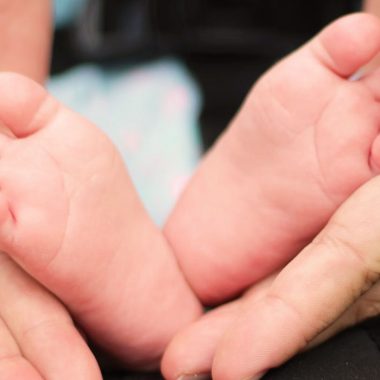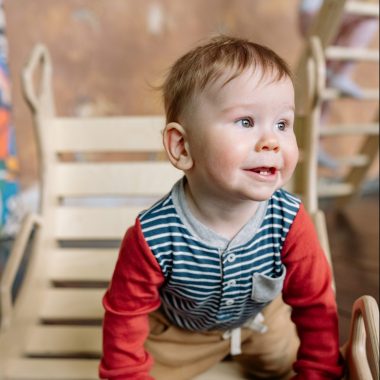Walking is an important milestone in your baby’s development.
It’s a sign that your baby is entering the toddler zone. This also marks the start of a new chapter in your life as a parent. It is a moment of pride, but it comes with challenges. From now on, you will endlessly chase your baby, whom you’ll find insatiable to explore the world.
There is a lot of variation regarding how and when babies take their first steps.
Some walk very early in the second half of their first year, while others take much longer. Some babies crawl before they walk, while others never do.
In this article, you will learn about when babies walk – including the typical timeline, stages, and signs to look out for.
How do babies learn to walk?
Long before taking the first step, your baby begins working on the skills that lead to walking.
For walking, a baby needs:
- strength,
- balance,
- coordination,
- ability to stand up,
- ability to shift body weight from one leg to the other,
- ability to support the body and
- ability to perceive the body in space.
ALSO READ: Vocal Development In Babies
These skills form the building blocks of walking and are complex. They take time to develop. Each new skill builds upon the previous skills acquired by your baby.
- Through tummy time, your baby learns to strengthen their core, leg, and arm muscles.
- As your baby grows, their center of gravity shifts to their hips and pelvis. This allows them to develop balance.
- With the development of neuromotor skills, your baby can learn to coordinate and take their first steps.
Usually, it takes babies a year to develop the skills required to start walking.
A simple breakdown, by month, of this process looks like this:
0-2 months
Your baby is in the process of learning and gaining neck control. During this period, they learn to hold their heads up.
3-6 months
During this period, your baby usually
- learns to lift their head,
- builds coordination,
- starts grabbing for objects,
- bounces (a great activity for the development of leg muscles).
ALSO READ: Dry Skin In Babies: Causes, Symptoms and Tips
7-11 months
During this period, many babies learn to crawl. However, not all babies crawl, and your baby might be one of the non-crawlers. Some babies skip this stage entirely.
Crawling helps your baby with,
- learning how to manage their body,
- building hand-eye connection,
- integrating reflexes,
- traveling specific distances
At about 9 months, your baby might start to pull themselves up in a standing position. Usually, babies use some form of support, such as nearby furniture, to achieve this position.
At 9 or 10 months, your baby will begin to learn how to bend their knees and sit down after standing. This marks a big leap in development.
12-18 months
During this stage, your baby may
- start to cruise, moving from one piece of furniture to another
- stand without support for a few seconds
- start to stoop and squat
- take steps while holding your hand
ALSO READ: Newborn Baby Care During Winter
When do babies start walking?
Babies, on average, start walking by 12 months. But some babies take their first steps as early as 9 months.
It is also normal for babies to take even more time and start walking by 18 months.
According to the Centers for Disease Control and Prevention (CDC), the general time range for walking is between 12-18 months.
CDC notes that babies might generally take their first independent steps around 12 months. And they typically walk on their own, completely unsupported, at around 18 months of age.
In general, experts emphasize that there is no perfect timeline between a baby’s first steps and independent walking. A baby can take a few steps and then fall back to crawling the next day again.
Walking independently may take months of practice, and there is quite a bit of variance with the “when” and “how” of walking.
How do I know if my baby is ready to walk?
A baby may be ready to walk when they
- have good head and upper body control.
- can coordinate their movements.
- can stand.
- begin to cruise or walk by pulling up on objects.
- take steps while gripping your hands.
- appear interested in the practice of walking.
ALSO READ: What Is Secure Attachment And Why Is It Important?
What are the stages of a baby walking?
Your baby will go through several stages of development before they start walking.
Your baby’s body will begin preparing early on by:
- Strengthening the bones and muscles.
- Developing the sensory system which allows a baby to maintain balance as well as understand the position of different body parts and how to use them for coordinated movement
- Developing the vision to enable spacial awareness
- Establishing the cognitive skill of motor planning, which allows a baby to plan and execute movements that help them safely navigate their environment, like stepping over or around toys in their path.
As you see, learning to walk takes months of skill development and is not easy.
Diving deeper into the different stages of walking, we have:
Sitting
Sitting without support means your baby has a strong core and that their head and neck control is fully developed. This commonly happens sometime between 6-9 months.
Sitting is a process. A baby sits with a little help at first, then learns to sit without support, and then begins to move in and out of the sitting position without assistance.
Expected age: 4-9 months
Creeping/Scooting
Creeping and/or scooting are referred to as a baby’s pre-crawling strategies.
Some babies choose the mobility route first, while others get straight to holding upright positions.
A baby may scoot on their belly, roll around, or creep forward. These first movements may seem a little strange initially, but you should trust the process.
All of these movements indicate that your baby is preparing for the next stage.
Expected age: 6-11 months
ALSO READ: Sudden Infant Death Syndrome: Causes, Risk Factors and Prevention
Crawling
This is an exciting time for you and your baby. Finally, your baby will gain some independence and begin exploring the world on their own.
Crawling may start sometime around 7 months.
Crawling can last for months, a few days, or not exhibit at all. Some babies never crawl – they go straight from rolling or creeping to walking. All of these variations are normal.
Crawling helps with
- strengthening muscles,
- establishing body awareness,
- left and right side coordination.
In classic crawling, the baby places their bodyweight on both their hands and knees. This is followed by crawling movements of moving one arm along with the opposite knee forward simultaneously.
Some babies adopt a different style of crawling such as bear, crab, rolling, commando, and bottom scoot crawling.
Expected age: 6-13 months
Stepping
As your baby gains upper body control, they may take a few steps with the aid of an adult. You can hold your baby’s hands or support their torso and encourage them to take small steps forward.
Expected age: 6-13 months
Pulling up
Pulling up begins as your baby gains upper body strength. Pulling up boosts a baby’s leg muscles and improves coordination.
Your baby will use the assistance of objects to stand up and may take a few steps. Unsupported walking is rare at this stage. Your baby will rely on nearby objects for support to move which takes us to the Cruising stage.
Expected age: 8-11 months
Cruising
Cruising is when your baby walks while holding onto objects.
This stage shows that your baby is learning to shift weight and balance while stepping. This is when your baby will also develop the ability to propel themselves forward.
Some babies use this strategy to move around the room quickly.
Be sure to create a safe path for your baby and check if any furniture used for support will not move or fall onto your baby.
Expected age: 6-13 months
Walking
This is the final stage. Your baby has worked hard for months to reach this stage. Typically, babies begin to walk after going through the aforementioned stages of development.
However, in some cases, babies can skip various stages on the way to walking.
Expected age: 8-18 months
ALSO READ: What Is The First Week With A Newborn Like
How can I encourage my baby to walk?
Walking and even learning how to walk is a lengthy and demanding process for any baby. Even after successfully going through all the stages of learning to walk, your baby will take a while until they begin to walk independently.
A baby has an innate drive to become mobile. The best thing you can do is to let them explore the world at their own pace. You can do this by providing a supportive physical and social setting for your baby.
The major principle of supporting a baby in walking is watching for cues. Observe your baby. If they are ready to advance, acknowledge every achievement and encourage progress.
It goes without saying that falling is inevitable in the process of walking. Make sure you are around to help your baby get back up again. At this stage, it is crucial to baby-proof the house properly.
Some other ways that you can encourage your baby to walk are:
Do not rush
Remember that every baby takes their first steps at their own pace. Encourage your baby to walk, but don’t force them into it. When your baby is ready, they will begin.
Lend a hand
Once your baby is standing and cruising, offer to support them. Of course, do not hover and refuse to let them practice independently.
Just make sure you are around in case they are in need of some help.
Play together
Playing is highly beneficial for a baby’s development – physically, cognitively, socially, and emotionally.
When you are with your baby or around them during playtime, they feel safe.
Playtime is a building block for establishing confidence and several other skills that aid in development and growth.
ALSO READ: Neonatal Jaundice – Types, Symptoms, Causes and Treatment
Expose your baby to different walking surfaces
Learning to walk on hard floors, grass, sand, etc. will improve your baby’s balance and coordination. Allow your baby to explore multiple types of walking surfaces under your guidance.
This indubitably hastens the learning process.
Keep their feet bare
A baby’s sensory system plays a vital role in balance and coordination. Your baby will receive important information and sensations through their feet.
Keeping your baby’s feet covered with shoes might interfere with this process. Make sure your home is baby proofed and then allow your baby to roam barefoot.
When should my baby start wearing shoes?
According to the American Podiatric Medical Association, walking around barefoot helps infants and toddlers develop strong, healthy feet.
Walking barefoot may
- encourage children to walk correctly
- help their muscles develop correctly
Experts generally recommend that once babies start walking, they do not need to wear shoes on safe, indoor surfaces. However, they should wear shoes outside or in areas where there might be potential hazards and parents/caregivers cannot keep a watch on them.
Should my baby use a walker?
The American Academy of Pediatrics recommends against using infant walkers.
According to a study, the reasons behind this recommendation are:
- Walkers provide infants with increased mobility, which often exposes them to hazardous situations.
- Most infant walker–related injuries occur when the child falls down the stairs in the walker.
- Walkers give infants access to environments and objects they might not otherwise be able to reach. This can result in proximity injuries, such as touching a hot oven door, grabbing sharp objects, or ingesting household poisons.
Moreover, experts say that walkers don’t allow babies to practice the balance and strength skills they need for walking. Hence, walkers don’t help babies learn to walk and are detrimental to their growth.
ALSO READ: Does My Baby Have Special Needs?
Why isn’t my baby walking yet?
Some babies take longer to walk. Remember that every baby has a different timeline and pace of growth.
The CDC recommends that you visit your pediatrician if your baby is not walking at all by 18 months or not walking steadily by the age of 2.
Talk to your baby’s doctor if your baby
- can’t stand when supported by 12 months
- can’t take steps on their own by 15 months
- develops skills but then loses them
- is not hitting the typical developmental milestones
References: medicalnewstoday.com, parents.com, webmd.com, whattoexpect.com, parentingscience.com, clevelandclinic.org, healthline.com, healthychildren.org, publications.aap.org,


